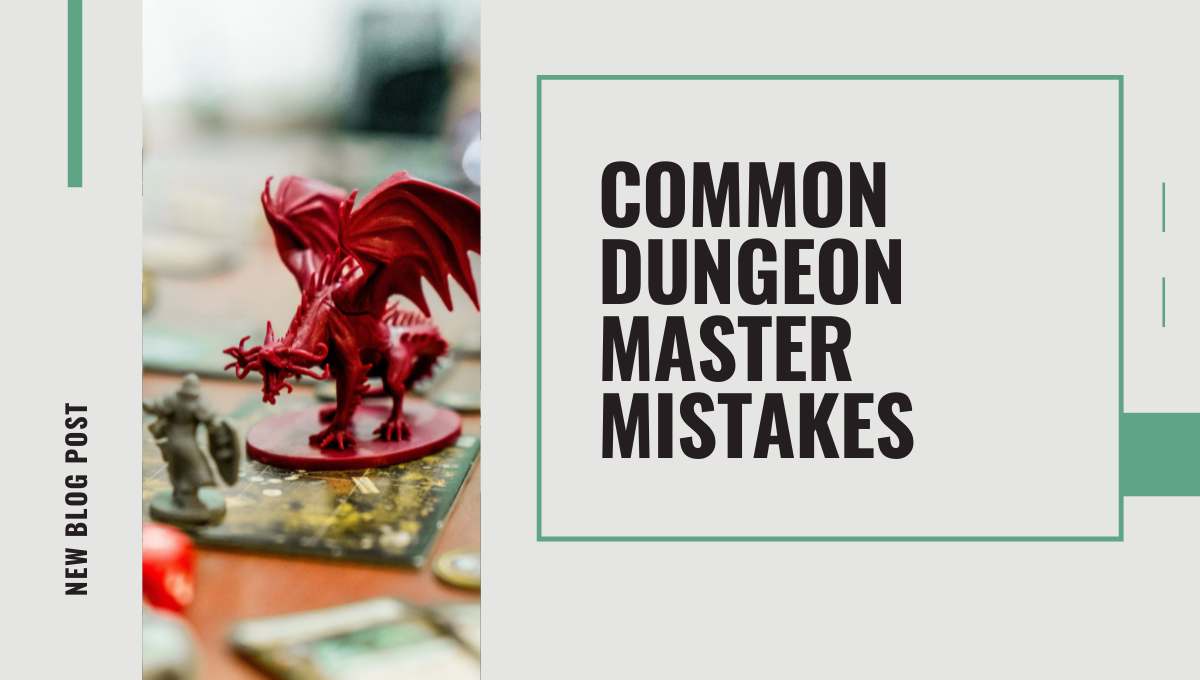
Common DM Mistakes
Kylie DeWitt
Being a Dungeon Master takes work. Being a good Dungeon Master takes practice. Luckily there are plenty of people with DM experience that can help you be the best Dungeon Master. We've compiled a few of the most common Dungeon Master mistakes in this list to help you avoid them. The first step is recognition after all!
Building a Story, not a Scenario
This is a common DM mistake. D&D allows Dungeon Masters to stretch their creative muscles. But remember, you aren’t writing a story. You’re writing scenarios. Your players define what the characters do in your world and in the situations you’ve created. They determine the NPCs they think are important. They define the path they wish to take.
Don’t get attached to NPCs or Villians. Don’t get attached to one path in your story. Your players will ignore beautiful characters, or find a different way to go. Or worse, kill the NPC because they’re murderhobos.
Taking Away Player Influence and Agency
It's important to allow your players the ability to influence the world that you created. Allow your players to have options, and not only the options you've created. If you take away the players' agency, their ability to choose their path, you lock the players on one path. That can suck the fun out of gameplay. Forcing limits on players is detrimental to the creativity that attracts so many to the world of D&D.
It is possible to limit options in a good way, you just have to be careful with how you do it. For example, Tomb of Annihilation offers the unique problem of a lack of resurrection magic. This fuels the story and also can have characters being a little more careful about what they do in the world. This limitation, however, is not for the sake of a limitation. It is a limitation that stems from the story and makes sense in the world. This idea should be done carefully.
Being the Bad Guy
Since you control all the enemies and villains in the game, it's easy to think that you're against the players. This is why this makes the common DM mistake list. But that kind of thinking will turn sour and D&D will lose its novelty. Instead, think of yourself as the story's narrator. The narrator in the story wants the main characters to succeed. There may be hardships and trials presented to the main characters. That's where the narrator comes in. But in the end, the narrator wants a good story.
To tell if you're having problems cheering on the players, think about your encounters. Do you find yourself throwing challenge after challenge in encounters at your players? Do you spend most of the campaign battling? While encounters are an important part of D&D, remember that it's not the only aspect of the game. Ask your players what they intend with D&D. What are their goals? What are their character's goals? What do they want from the story? If you’re asking yourself and your players what they want, you’ll break the habit of being the adversary of your players.
Ignoring What the Players Want
This falls in line with not being the players’ adversary. Keep in mind that your players are not an audience. They are not here to listen to your story. They are at the table to build a story with you.
As Dungeon Masters, we pour our hearts and souls into world-building, campaigns, and story arcs. This is a fantastic way to develop a convincing and unique story, but it’s important to be flexible.
Do not try to develop a story without first acknowledging what the players want from the game. We owe it both to ourselves and the players to create a campaign where everyone is having fun. A game that players want to keep playing.
One of the easier ways to do this is to start with a session zero. In a session zero, you can touch base on what players want before building out the full campaign. I’ve developed a quick list of questions for session zero that is available for download on ko-fi.

Over Preparing (or Under Preparing)
This is a very common mistake, one that will take a lot of time and practice to overcome. Players will be players. They will mess up all your neat little plans. This may prompt you to try to prepare for every little thing possible. Or it may prompt you to improvise the entire session.
Preparing for every possible trajectory the players might take is not only impossible but also presents a very real problem for DMs: Burnout. Planning every little detail takes a tremendous amount of time and effort. To do so runs the risk of damaging the fun that is running a D&D game.
You cannot plan for everything. Your players are creative; D&D is a game of imagination. They also outnumber you. If there’s a way to overcome this hedge-maze-of-traps puzzle, they’ll find it. You cannot force your players to take a path you planned for. (At least not every time, there are creative ways to keep your players on track that DO work). It can be disheartening to plan something out only for it to be dashed against the rocks.
Conversely, trying to improvise the entire session should be left to the experts. Even then, it is very hard to accomplish in a way that delivers a good game. Some improvisation is definitely needed. But it's stressful to try to improvise the whole game. It also creates distrust from your players, who will feel you won’t be able to create a good game.
Balancing the Spotlight on All the Players
Some players, whether new or old, are way more comfortable at the table. It’s easy to let players who want to lead, lead the direction that the group wants to go in. While they may like being in the lead, it’s important to engage with everyone.
A shy player won’t stretch their wings if you don’t give them the room to do so. Interacting with each player, in turn, keeps them interested in the game. It also allows you the opportunity to provide each player with what they are looking for from the game. This could be encounters, roleplaying, puzzle-solving, or more.
Learning When to Say Yes or No
 In general, D&D is a game of yeses. It’s a game of fantastical creatures and mystical lands. It’s not unlikely that a player would have the ability to jump off one giant’s head and crash down with their axe on the second. You want to be a yes man as much as you can.
In general, D&D is a game of yeses. It’s a game of fantastical creatures and mystical lands. It’s not unlikely that a player would have the ability to jump off one giant’s head and crash down with their axe on the second. You want to be a yes man as much as you can.
That said, there is a time and place to say no. The obvious no is when it breaks a fundamental rule. But other no’s are not so obvious. To figure out whether you should say yes or no ask yourself these questions:
-
Will it alter the adventure in a negative way?
-
Will it give the player an unfair advantage?
-
Will there be consequences later on that you’ll regret?
It’s important to note that you can say “No, but…” or “Yes, and…”.
For example: “No, you can’t jump off the head of the giant, but I will allow you to run up the arm of the other giant if you make an acrobatics check.”
Or: “Yes, you can jump off the head of the giant, and I’ll need you to make an acrobatics check to see if you leap far enough to hit the other giant in the head.”
It’s a rough example, but there are plenty of times either method can be used to direct the players.
Lack of Consistency
We’re not talking about mistakes here. There are a lot of rules to remember in D&D, and while you should have a good handle on them, it’s easy to make mistakes. We’re humans, not robots. You can easily return to the table later and retcon any major rule breaks. What hurts the game is inconsistency.
Your players need to be able to trust you. They need to know that you aren’t playing favorites or bending the rules for yourself. Flipping between rulings to benefit yourself will suck the fun from the game. It can also cause the players to resent you. If you say that taking a potion is a bonus action one time, you cannot say it’s an action the next. Trust is key to an enjoyable experience.
Handling Out Too Many Magic Items Too Early
Players want cool magic gear. It’s a no-brainer. They may ask you a million times for magic shops and +1 weapons. While it’s important to hand out some magical rewards, make sure that you aren’t handing out too many. You never know what item you forgot that they will use to completely wreck that boss battle.
Make sure that any items you do hand out are appropriate for their level. Use the Dungeon Master’s Guide for reference in determining what items to hand out at what levels. There’s a handy table in DMG to help you with this. Plus there’s a reason they put all that time into making a ranking system for items.
Learn to Let Go of Control
The solution to most of these problems is learning to let go of your creation. You and your players have come to the table to create a story. Together. Allowing players to do cool moves or be in the spotlight will be more fun in the long run. Don't try to control the players' every move. While you have some control of the world and story direction, you cannot, and should not, control the players.
we hope these few common DM mistakes will help you be more aware at the table. Good luck DM!
Check Out Our Other DM Resources!
I’ve begun compiling a few of the resources I’ve found super helpful in this list. They may be helpful to you. If you haven't checked out Sly Flourish's version of this list, you should. He offers lots of great information for new DMs.
If you’re looking for a great way to organize your campaign notes, check out our Dungeon Master’s Guide to Adventure: Campaign Diary. Because what DM hasn’t found the need to organize all the copious amounts of work they put into their campaign?


